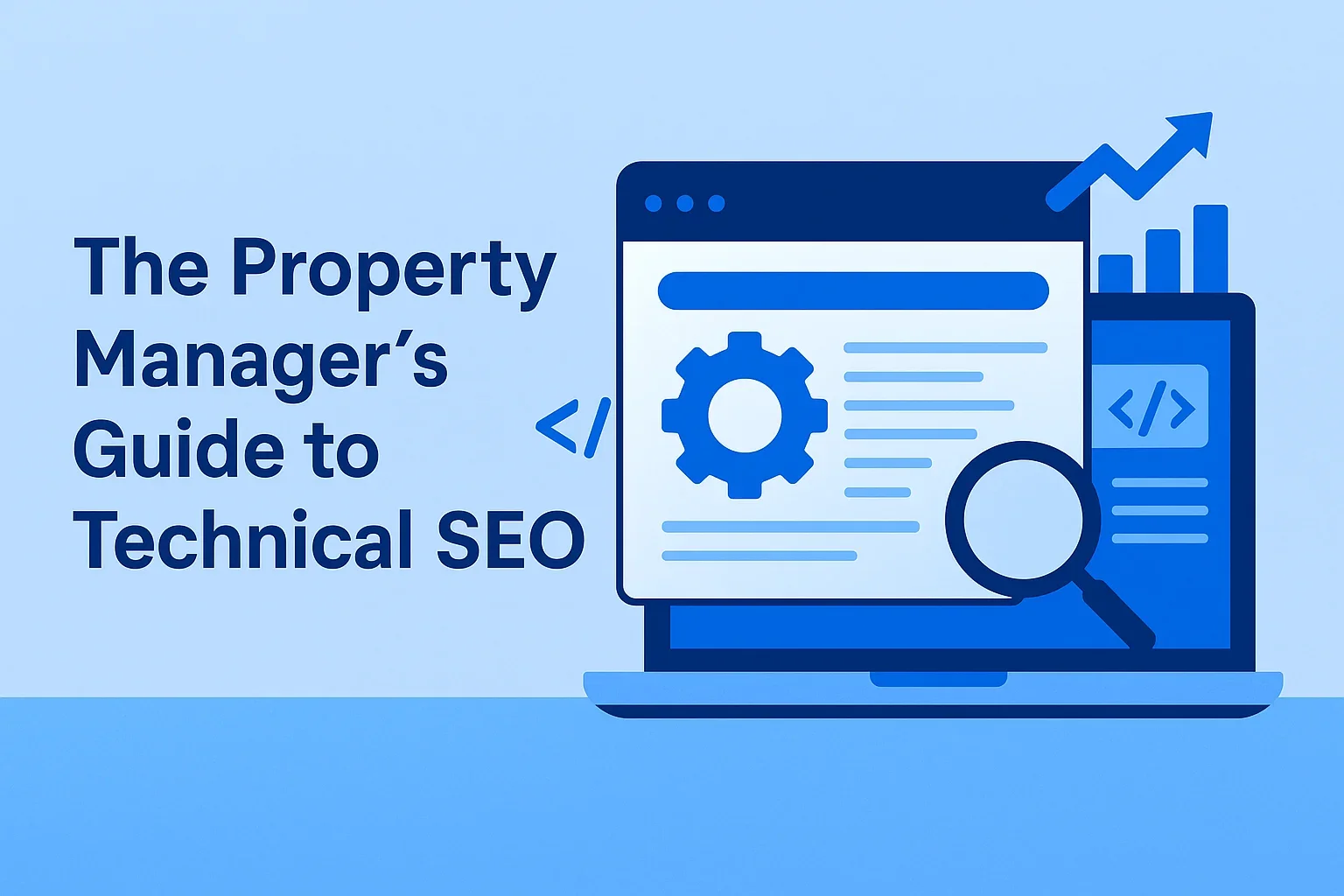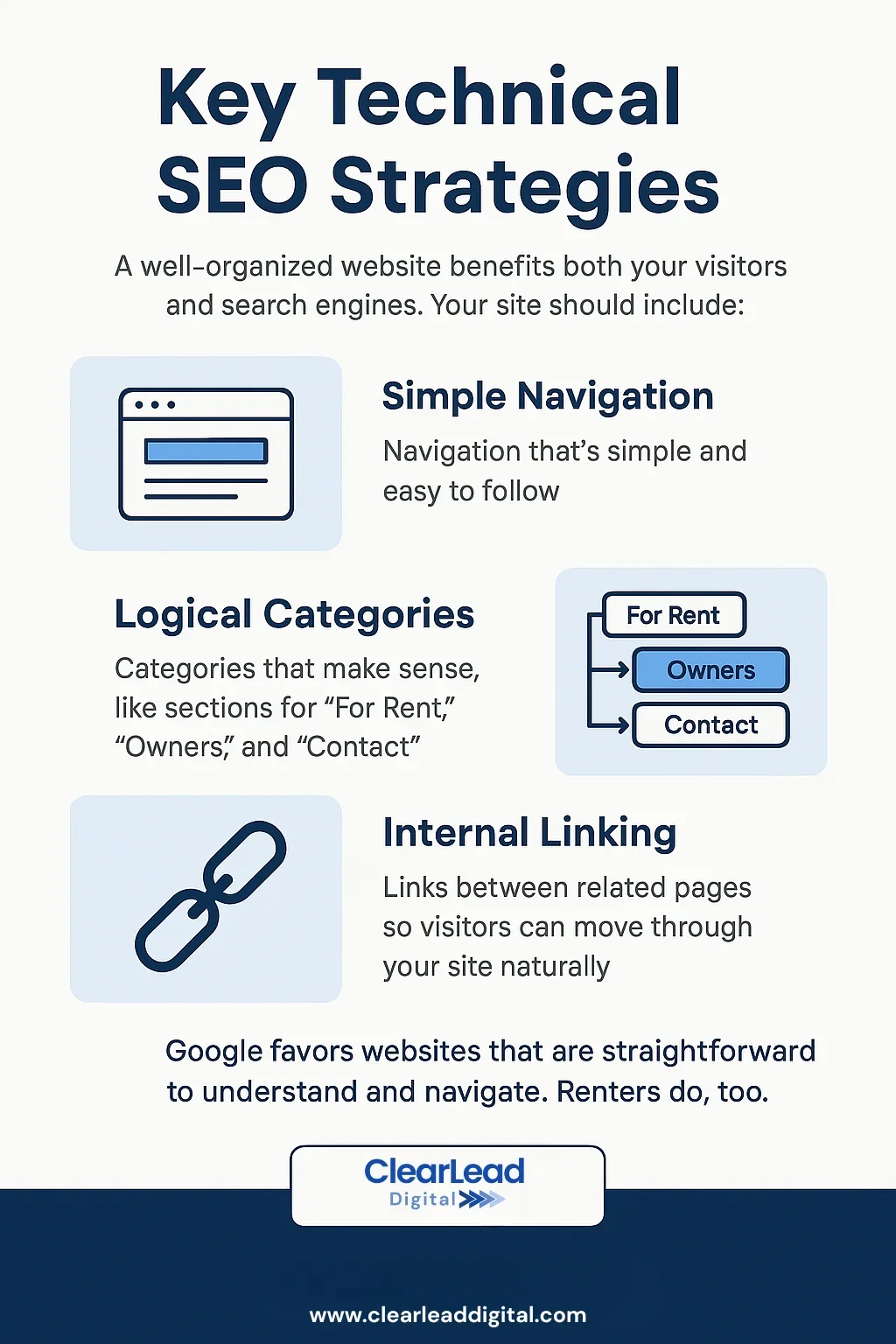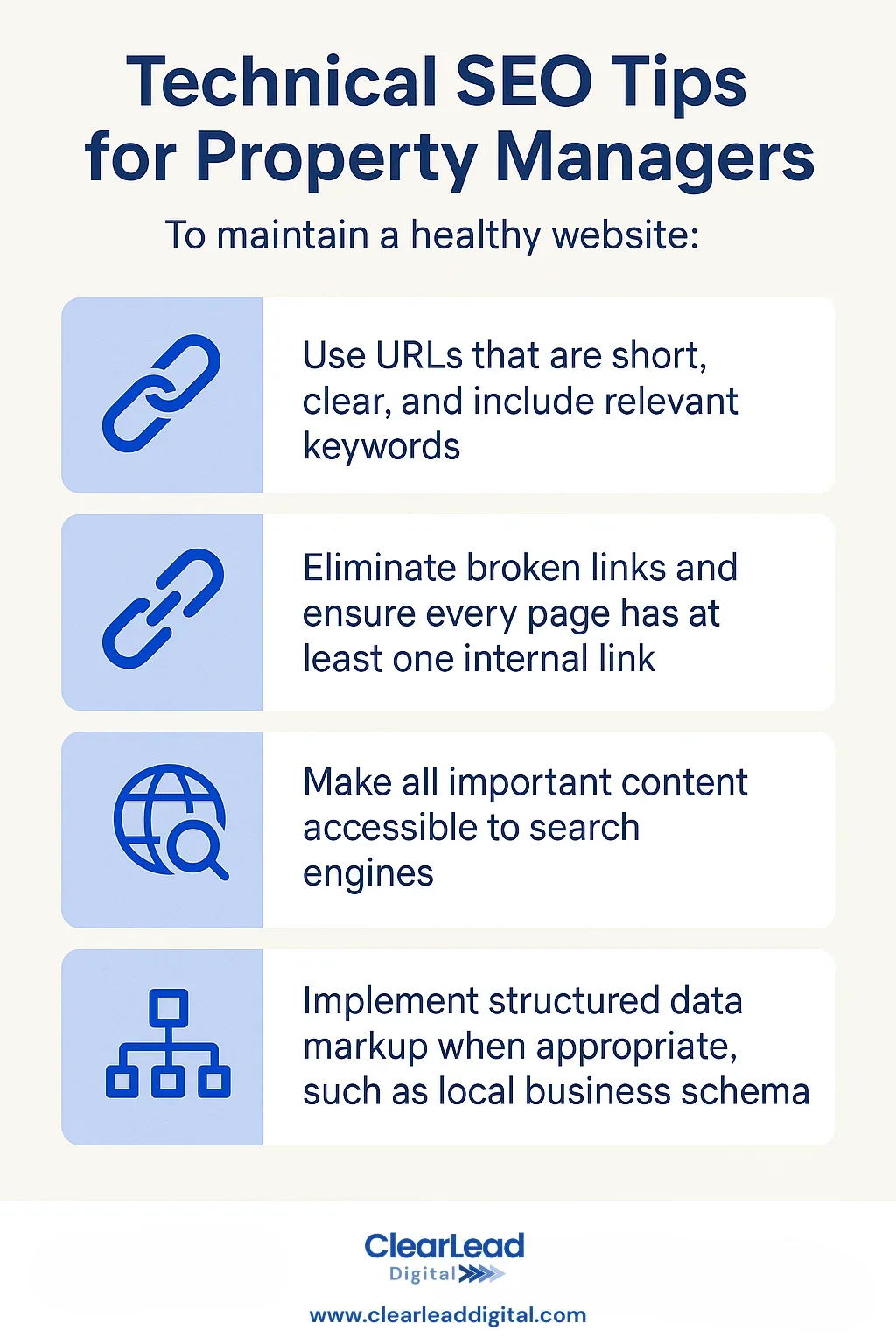2025 Guide to Technical SEO For Property Management Websites
Running a property management website means your site needs to be easy for search engines to understand. Technical SEO for property management websites focuses on making sure your site works smoothly behind the scenes so potential renters and owners can find you without trouble.
Table of Contents
Understanding Technical SEO
If you manage rental properties, your website isn’t just a digital business card—it’s a lead-generating machine. But without solid technical SEO, your site may never reach the people who need to see it.
What is Technical SEO?
Technical SEO refers to the behind-the-scenes work that makes your website easy for search engines to crawl, index, and rank. It’s not about keywords or content. It focuses on making sure your site loads quickly, performs reliably, stays secure, and works well on mobile devices.
For property managers, that means having a website that runs faster, ranks higher, and brings in more qualified leads.
Why Technical SEO Matters for Property Management
Your site competes with dozens or even hundreds of other property management businesses. If it loads slowly, is difficult to use, or doesn’t display well on phones, Google will rank it lower.
Technical SEO offers benefits such as:
Making your site easier to find in search results
Helping pages load quickly and run smoothly
Delivering a better experience on mobile devices
Building trust with property owners and tenants
If you want more visitors, higher conversion rates, and a professional online presence, technical SEO must be your starting point.
Key Technical SEO Strategies
A well-organized website benefits both your visitors and search engines. Your site should include:
Navigation that’s simple and easy to follow
Categories that make sense, like sections for “For Rent,” “Owners,” and “Contact”
Links between related pages so visitors can move through your site naturally
Google favors websites that are straightforward to understand and navigate. Renters do, too.
Mobile Optimization
Since most visitors use smartphones, your site must work well on small screens. Without mobile-friendliness, Google will penalize your ranking.
Make sure your site:
Adapts its layout to different screen sizes
Loads quickly when accessed on mobile networks
Includes buttons and links that are easy to tap
Use Google’s Mobile-Friendly Test to check how your site performs on phones.
Page Speed Optimization
If your pages take more than a second to load, many visitors will leave. Speed affects rankings and user satisfaction.
To boost page speed, you can compress and resize images, reduce the size of CSS and JavaScript files, enable browser caching to store data locally, and choose a hosting provider known for reliability.
Tools like Google PageSpeed Insights or GTmetrix can help you identify specific speed issues.
SSL Certificates and Site Security
Websites that use HTTPS are more trusted by both Google and users. If your site lacks an SSL certificate, you should install one immediately.
Beyond SSL, keep your content management system and plugins updated, host your site securely, and enable firewall protection and monitoring to guard against threats.
XML Sitemap Creation
An XML sitemap acts like a map of your website for search engines, helping them find and index your pages more efficiently.
Your sitemap should list all the important pages, update automatically as you add or remove content, and be submitted through Google Search Console.
Robots.txt File Management
The robots.txt file directs search engines on which parts of your site to crawl and which to ignore.
Make sure you don’t block any valuable pages by mistake. At the same time, prevent search engines from indexing irrelevant or duplicate pages, such as admin login areas. Test this file regularly to avoid errors.
Implementing Technical SEO
Audit Your Current Site: Improving your site’s technical SEO doesn’t require a developer, but it does begin with an audit.
Use tools like Google Search Console to spot indexing or crawl errors. Google PageSpeed Insights can reveal slow-loading pages. SEMrush or Ahrefs help identify broken links and duplicate content.
Pay attention to slow page loads, mobile usability issues, and any pages that Google hasn’t indexed
Tools and Resources for SEO Analysis
Some free and paid tools that can assist you include:
Google Search Console, which shows how Google sees your site
Google Analytics for tracking user behavior
SEMrush or Ahrefs, which provide deep SEO audits
Screaming Frog, a tool for crawling your website and spotting problems
These tools make it easier to monitor your site’s health, fix issues, and stay competitive.
Technical SEO Tips for Property Managers
To maintain a healthy website:
Use URLs that are short, clear, and include relevant keywords
Eliminate broken links and ensure every page has at least one internal link
Make all important content accessible to search engines
Implement structured data markup when appropriate, such as local business schema
Common Issues and How to Fix Them
Some frequent technical problems you may encounter:
Pages that load slowly often benefit from image optimization and cleaning up scripts
Duplicate content should be managed with canonical tags
If your site lacks SSL, install a certificate and redirect visitors to HTTPS versions of pages
Ongoing Maintenance and Monitoring
Technical SEO requires ongoing work. Regularly review your site’s performance, check crawl reports, apply security updates, and test mobile usability. Setting up a monthly reminder to go over these areas helps keep your site in good shape.
Conclusion
No matter how strong your content is, technical issues can prevent your site from ranking or providing a good user experience. Search engines expect sites that load fast, are secure, and work well on any device.
For property managers, investing in technical SEO improves visibility and brings in more qualified leads.
Next Steps for Property Managers
To get started:
Conduct a technical SEO audit of your site
Address basic issues like slow speed, poor mobile usability, and missing SSL
Put a plan in place for regular monitoring and updates
Consider using SEO tools or consulting a professional for more complex tasks
You don’t need to fix everything at once, but avoiding technical SEO is a missed chance to grow your business.
FAQ About Technical SEO
-
Technical SEO involves the technical aspects of your site, including page speed, mobile usability, secure connections, crawlability, and site organization. It helps search engines access your site and ensures visitors have a smooth experience.
-
Most people use phones to browse properties. If your site doesn’t work well on mobile, visitors will leave quickly and Google may rank your site lower.
-
Free tools like Google Search Console, PageSpeed Insights, and Screaming Frog can help you find indexing problems, speed bottlenecks, and broken links.
-
Technical SEO deals with your website’s infrastructure, while on-page SEO focuses on the content itself, like keywords and formatting. Both are important for search rankings.
-
Optimizing images, reducing file sizes of scripts and styles, enabling caching, using a content delivery network, and choosing a fast host will make your pages load quicker.
-
An XML sitemap lists your important pages to help search engines index them. It should be submitted via Google Search Console.
-
At least every three months, or whenever you add new pages, redesign your site, or notice a drop in traffic.
-
Your visitors may get warnings in their browsers, which can reduce trust and traffic. Google also prefers HTTPS sites.
-
Yes, it tells search engines which pages to crawl or avoid, helping them focus on the right content.
-
Many basic tasks are manageable with free tools and time, but complex issues or competitive markets often require professional help.



